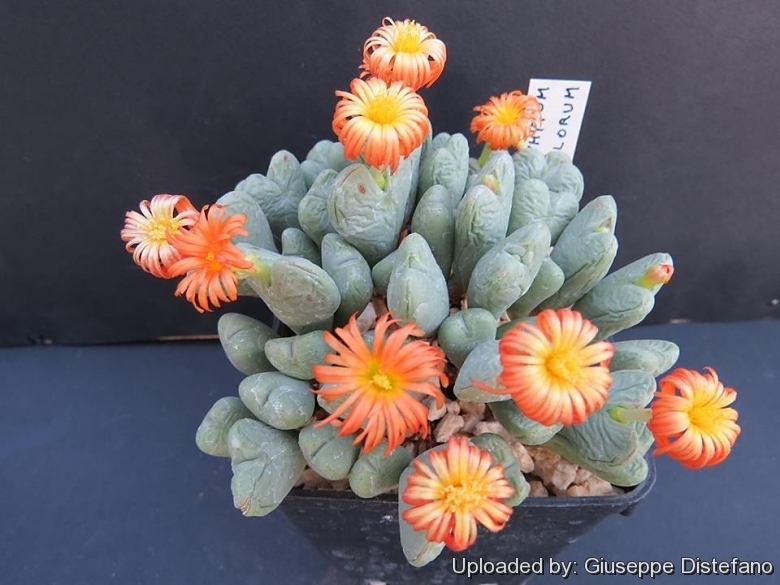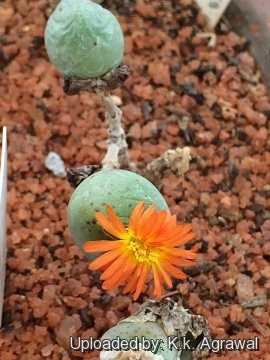
Conophytum х cupreiflorum Photo by: Giuseppe Distefano
Origin and Habitat: Conophytum x cupreiflorumSN|26013]]SN|29168]] is a rare succulent plant from Namaqualand, NC, South Africa. It came perhaps from around Kourkam, where Conophytum meyeriSN|1166]]SN|18940]] and Conophytum velutinumSN|21975]]SN|21975]] ssp. polyandrum, the most probable parents, co-occur. Another possible area of origin may be the area around Springbok, where Conophytum bilobumSN|18940]]SN|1166]] and Conophytum violaciflorumSN|29168]]SN|26013]] hybridize.
Synonyms:
Common Names include:
KOREAN (한국어): 쿠프레이플로룸
RUSSIAN (Русский): Конофитум медноцветковый
Description: Conophytum cupreiflorum is a tiny densely branched succulent named for its rich coppery-red blooms and forms low clumps or dense mats. The material on which the description was based was probably a natural hybrid sent to Tischer from South Africa without details of the origin.
Stem: Stemless (internodes invisible) or very short and forming rhizomatous branches at soil level.
Bodies (paird leaves): Turbiniform (inverse conical) to cordate (heart shaped) in outline, apex not sharply keeled, to 25 mm tall, 15 mm thick, dark green, glabrous. The epidermis could be maculate from small and larger scattered tannin idioblasts.
Flowers: Petals spreading, bright orange to coppery-red with yellow at the base.
Blooming season: The flowers are autumnal (rarely in summer) and diurnal. They are short-day plant (flowers only when day length is less than 12 hours.)
Fruits: Small, tan coloured usually 5-locular.
Bibliography: Major references and further lectures
1) Heidrun E.K. Hartmann “Illustrated Handbook of Succulent Plants: Aizoaceae A-E” Springer, 2002
 Conophytum х cupreiflorum Photo by: K.k. Agrawal
Conophytum х cupreiflorum Photo by: K.k. AgrawalSend a photo of this plant.The gallery now contains thousands of pictures, however it is possible to do even more. We are, of course, seeking photos of species not yet shown in the gallery but not only that, we are also looking for better pictures than those already present.
Read More... Cultivation and Propagation: Conophytum cupreiflorum is a "winter" grower which is most active from late winter until later spring and heading for summer dormancy, but in favourable growing conditions it keeps going over the summer too and doesn't need particular care. It is relatively easy to grow.
Soil: Requires good drainage as it it is prone to root rot. It can grows outdoor in sunny, dry, rock crevices (protection against winter wet is required) It can also be cultivated in alpine house, in poor, drained soil.
Watering: It requires little water; otherwise its epidermis breaks (resulting in unsightly scars). Occasional misting in summer, water regularly in winter after the previous year leaves have dried up. Requires good drainage.
Fertilization: Feed it once during the growing season with a fertilizer specifically formulated for cactus succulents (poor in nitrogen), including all micro nutrients and trace elements diluted to ½ the strength recommended on the label. It thrives in poor soils and need a limited supplies of fertilizer to avoid the plants developing excess vegetation, which is easily attacked by fungal diseases.
Exposure: Keep cool and shaded in summer, it needs full sun or light shade.
Temperature: Hardy to -2°C. Ensure a very good ventilation.USDA zone 9-12
Repotting: Avoid to repot frequently. This plant may stay in the same pot for many years.
Uses: Container, rock garden.
Pests and diseases: It is vulnerable to mealybugs and rarely scale.
Propagation:: It can be reproduced both by cuttings and seeds. Take the cutting from a grown-up mother plant. Each cutting must contain one or more heads along with a fraction of root. It is easily propagated by seed.











